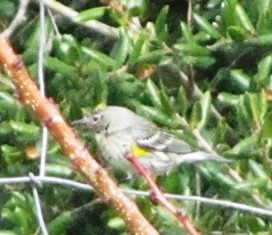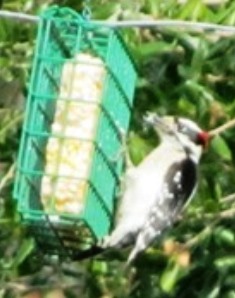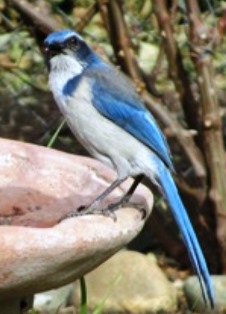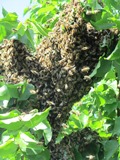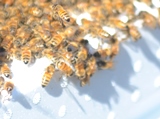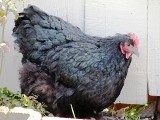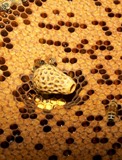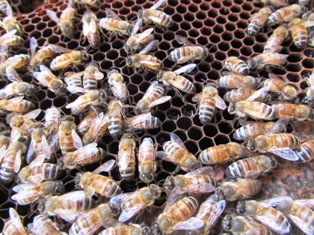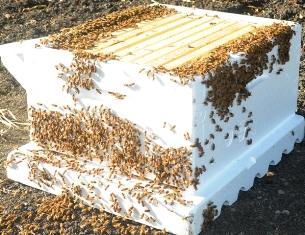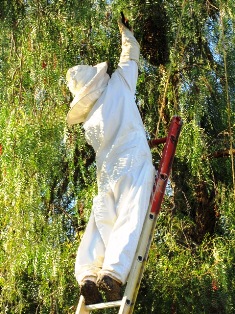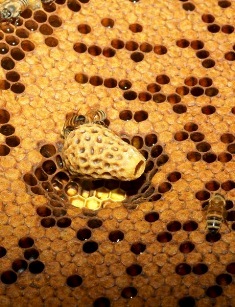Blog Archives
Telltale Signs of Spring
As I write this, the honeybees are scouting every plant on the property. Awakened by warm weather and sunlight, they search for nectar. Aside from a few California poppies and other wildflowers blooming in front of the house, they won’t find much to forage on just yet.
Of course, there are a few apricot, nectarine, and almond tree blossoms as well as a smattering of white strawberry blooms in the raised beds at the back of our property. But within a few weeks, the warm weather of March and April will render the farmette virtually covered in masses of sweet offerings for the honeybees.
Still, there are the early signs of spring. The Japanese maples are leafing out in a dazzling show of red color. The pregnant stems of our bearded iris are swelling now for their Easter bloom cycle. And the Greek oregano is popping up everywhere as it does this time of year.
Birds are building nests, but I haven’t seen the red-breasted robins just yet. When they show up, searching for worms and grubs, I will know spring has truly arrived. Until then, I look for the telltale signs that Mother Nature is about to robe herself in the splendid garments of spring–fruit tree blossoms, leaves, blooming wildflowers, and lovely kitchen herbs pushing up all over the place.
Yellow-Rumped Warbler and Other Songbirds Act Like It’s Spring
It’s the middle of January but tell that to Mother Nature whose songbirds are singing like it is spring. With our temperatures expected to exceed 70 degrees Fahrenheit in parts of the Bay Area today, the birds are gathering around feeders and fountains and the bees are buzzing about, too.
While having coffee on the patio this morning, I had the privilege of being visited by a variety of winged friends, some seemingly oblivious to me and my camera.
The woodpecker announces himself with the familiar rat-ta-tat-tat while the yellow-rumped warbler and other songbirds hang out in the firethorn bush, in the oak trees, and at several fountains we’ve placed at the rear of our farmette.
There’s a lot of bee traffic today. With warm days forecast for the next week or two, the bees could get the wrong idea and swarm. That would undoubtedly surprise the local backyard bee hobbyists.
So while I love the warm weather–especially when I read about the polar temperatures causing such misery in the Midwest and along the East Coast–like many Californians, I am beginning to worry about the looming possibility of a drought this year and mandatory water rationing.
But, then again, there’s something magical about hearing songbirds trilling in the dead of winter when the fruit trees in the orchard and the roses lining the path to the front door remain soundly asleep. I think I’ll have another cup of coffee and sit for a while longer.
Henny Penny Farmer’s Almanac–Sayings
Humans could learn a thing or two from the world of honeybees where all endeavor benefits the entire colony, not an individual bee.
A tea made of meadowsweet, chamomile, or peppermint herbs can calm an upset stomach.
To get stronger egg shells, feed your chickens extra calcium.
Producing manure is easy; it’s the moving of it that takes patience and the right shovel.
Sow above-ground plants during a waxing moon and below-ground plants during a waning moon.
The simplest treatment for a bee sting is to get the stinger out.
Move chickens and bees at night; when they awake in the morning, the move is a fait accompli.
If you enjoy listening to songbirds, it might interest you to know the male is generally the singer since he uses song to attract a mate and defend his territory.
Birds don’t just sing; they call, and their calls are how they communicate
with a partner or sound the alarm that a predator is near.
Box and jug wines are fine as long as you never drink or cook with a flawed wine.
Use a dab of raw honey or bee propolis to treat a peck wound on a chicken as honey and propolis have antiseptic, antibacterial properties.
Each nostril of a dog’s highly sensitive nose can separately track scents—a skill proving useful to humans in finding illegal drugs, locating dead bodies, and even detecting cancer.
Red wine remains drinkable for decades because the tannins act as a natural preservative; however, the wine must be properly bottled and stored.
If you want to lower your cholesterol, decrease your stress level
and improve your blood pressure, adopt a dog.
Pacific oysters can engage in annual sex reversals; male one year, female the next—one of nature’s many surprises.
Help your chickens go through the molting process (when they lose feathers and stop egg production) by feeding them 20 percent more protein and limiting their stressors.
Time spent in a garden is a lot like yoga; it slows the breath, quiets the mind, and lets you get to the truth.
To break your dog’s habit of licking you, get up and go into another room
immediately when the licking starts so the animal will associate its licking with your leaving.
If you don’t want to be devoured by insects, wear light colors when gardening.
If you want to strengthen your immune system, consume a teaspoonful of raw buckwheat honey every day.
A honeybee queens live 10 times longer than her worker bee sisters and while they are sterile, the queen remains reproductive throughout her life.
To keep your bee colony strong and robust, feed your honeybees when their food sources become scarce.
To make a fat-free broth, pour the juices of a roasted chicken or turkey into a wide-mouth jar and refrigerate until solidified; then, skim away the fat that has risen to the top.
You can’t shift the status quo if you don’t take action.
When relationships sour like beans and bitter herbs, an hour in a garden
can generate the sweetness of new dreams.
©November 2013 by Meera Lester
Permission is granted for use of individual quotes, provided the quoted material contains the following credit: “Used with permission from Henny Penny Farmers’ Almanac.”
An Extra Blanket for the Bees
With Thanksgiving only a couple of weeks away, weather is turning downright frosty at night. I asked my beekeeper neighbor if it was time for us to throw some blankets over the hives to help the beleagured honeybees stay warm. We did this last year along with feeding the bees with a good result of thriving hives in the spring.
In the wintertime, the honeybees cluster toward the middle of the hive, their muscles responsible for flight now shivering (albeit in a different way than when taking flight), to generate heat. The colder it gets, the tighter the cluster and harder the bees have to work to stay warm. If the the core temperature of the hive drops too low, the colony will die. See http://indianapublicmedia.org/amomentofscience/honeybees-winter/
During winter months, proper ventilation to maintain a dry hive is a must. Since bees eat and metabolize honey to generate heat, carbon dioxide and water are produced. The carbon dioxide, heavier than air, descends and exits the bottom of the hive while the water vapor rises to the cold inner roof and drips back down as condensate on the poor bees. Freezing and starvation can cause bee die-offs in the winter.
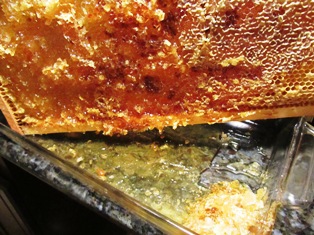
Bees eat and metabolize honey from stores within the hive during winter when outside food sources are scarce
We drape each hive with a blanket over the top and around the back and sides, but not in front where the openings are located. Bees need to be able to enter and exit. As soon as the temperatures warm, my neighbor and I pull back the blankets during the day.
Some might suggest that putting out an extra blanket for the bees is interfering with nature’s processes and survival of the fittest, but on the other hand, the colony has remained strong and healthy over this last year.
Human use of pesticides has wreaked untold harm on the population of these important pollinators. Isn’t it about time, we considered the plight of the bees and did something to help them survive, like planting excellent food sources for every season and giving them medicine when they need it an an extra blanket for warmth? See, http://www.mariasfarmcountrykitchen.com/help-honey-bees-survive-winter/
Paper Wasps Under the Eaves
The small, yellow-striped paper wasps have built two nests under the eaves. These insects are considered agriculturally beneficial, but they tend to get a little too close for comfort. The nests are right above my front door.
The nests are open-cell structures held together by fibers that the queen has masticated from wood posts (and sometimes woody plant stems) and mixed with saliva to create the cells of the nest. The nest can be grow to six to eight inches across in order to accommodate a growing population.
Paper wasps feed their offspring caterpillars, beetle larvae, corn earworms, flies, tobacco hornworms, armyworms, and other insects.
These wasps can sting multiple times, unlike the gentle honeybee that can sting only once. Earlier this year, when we were working on our front windows and door, I was stung four times on my cheek. For people allergic to bee stings, the sting can be life-threatening. It’s recommended to wear a bee suit when removing the nest as the wasps will attack in response to the threat to their nest.
The best time to remove the nest is evening when the wasps are less active and on the nest. High pressure water can be used to knock down the nest. I wrapped a hand towel saturated with a strongly scented kitchen cleaner. I took the nests down and then quickly went back into the house. The next day, a random paper wasp was back, apparently ready to rebuild. What was I to do, but reapply the smelling kitchen cleaner. The wasps are gone now.
Food for Bee Babies
The bee suit I’ve worn this morning smells like smoke from the smoker. My neighbor opened his hives today to check on the status of the bees and I was happy to help. I learn something new every time I work with him. We’ve had freezing nights with the temps hovering below 30 degrees Fahrenheit, not good for bees.
Upon opening the first hive, we could see the bees were docile. After all, it is winter. The bees must work hard to keep heat in the hive and they aren’t expecting us to be intruding into their world. In fact, my neighbor didn’t bother with putting on either the beekeeper suit or the elbow-length leather gloves. He loves his bees and has no fear of being stung.
Our work today was putting into each super a patty of brood building food (mainly high fructose corn syrup, soy flour, and other nutrients) as a substitute for pollen, especially necessary to feeding bees. Beekeepers often feed their bees in late winter or early spring since there is little pollen to be scavenged from flowers. Flower and blossom pollen comes later in the spring.
We must do all we can to help the beleaguered little honeybees. We have even covered their hives with blankets, reducing the necessary labor of the worker bees in keeping the hive humming and warm.
So I don’t mind smelling a little like smoke for a while to help the bees, and I’m hoping the bees won’t mind that I took one little frame of honey from their hive to my kitchen.
Beekeepers: Take Note of Your Local Regulations
Backyard beekeeping has become a hot hobby . . . and it has come at an important juncture in the history of our planet. For several years, honeybee populations have been dwindling and bees mysteriously disappearing in Europe and America. This is worrisome since the bees are necessary for pollination of crops.
Perhaps you live in a city or town that supports beekeeping and has written that support into the municipal code or state law. Count yourself lucky to have all those little honeybees to pollinate your garden–even if you aren’t the beekeeper. But if you love honey, like I love honey you’ll want your own hive.
Before you go shopping for your beekeeper suit, check out your town’s municipal code and zoning regulations that cover the keeping of bees. Also, find out what state regulations might apply. Your town might not even permit beekeeping.
California law requires beekeepers to notify their counties. Having the law on the books, however, doesn’t necessarily mean the law is rigorously enforced. Lack of funding for oversight and enforcement makes it difficult to ensure the community’s beekeepers are compliant.
You might have to spend a little time trying to decipher the language in your municipality’s documents. Cities in the San Francisco Bay Area, have ordinances and regulations governing beekeeping that differ as widely as the language (contained in their documents) used to characterize bees. Bees as livestock . . . or exotic animals. Really?
Foster City and Fremont, both south of San Francisco, but on opposite sides of the bay, ban beekeeping. Further south, the cities of Palo Alto and San Jose require permits. So do some cities north of San Francisco, including San Rafael, Sausalito, Fairfax, and Tiburon. In Concord, it is unlawful to keep hives or maintain an apiary in the city, except under certain conditions. No hive within 25 feet of the property line and a sign at the front of the property advising of the presence of bees.
If you are a honey loving, aspiring beekeeper/gardener, I hope you are in one of those towns across America that recognizes the value of these little pollenizers. The populations of these beleaguered, little creatures are dwindling as if they were under siege. When your city/county/state supports your efforts (with the honeybees, of course), everyone wins. Best of all the honeybees and the planet wins. Imagine having to pollinate the gardens and fields of the world by hand. Now that’s a sobering thought.
The Inherent Gifts of Observation
I saw some wild turkeys today strolling through the acre behind the farmette. If I hadn’t noticed them, I wouldn’t have captured them on film. They disappeared as quickly as they showed up. You have to pay attention for the moment is soon lost.
Some people never lose that childlike wonder of noticing everything in their environment. My grandfather was like that–a veritable treasure trove of information based on the observations of his world. An attitude of gratitude seems to come easily to such individuals, as if noticing and feeling thankful are linked.
The Buddhist practice of mindfulness suggests that kind of noticing. For example, if you spot a flower while out walking (perhaps it even grows through a crack in the sidewalk), you might bend down to examine the flower. Does it offer a fragrance, beauty in its perfect symmetry, a ladybug on it’s stem, delicate leaf, or a gentle sway in the breeze as if it is dancing? These are the gifts the flower offers, the gifts it holds for you when you take the time to notice.
I like working with the bees and seeing up close their world within the hive. I had never seen a “queen house.” When I did for the first time I felt astonishment at how perfectly functional it was. Honeybees create comb to seal in the honey–their food (and ours)–and these honeycombs and queen houses are functional, perfectly formed, and beautiful to gaze upon.
For my grandfather (and also in my own experience) observing nature’s glory conjures feelings of appreciation for so many blessings–the ability to see, hear, feel, touch, think, and sense what is present, what co-exists around us. This renders the perspective that we humans are mere specks in cosmic creation.
Our lives are richer when we appreciate what we have and take time to notice how richly adorned our lives are.
 Facebook
Facebook Goodreads
Goodreads LinkedIn
LinkedIn Meera Lester
Meera Lester Twitter
Twitter







